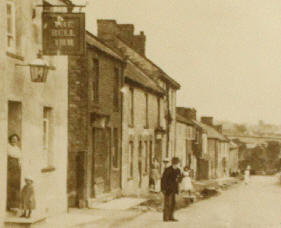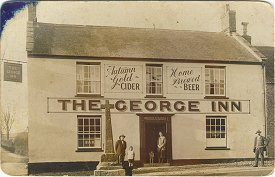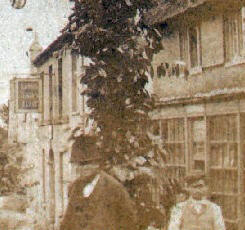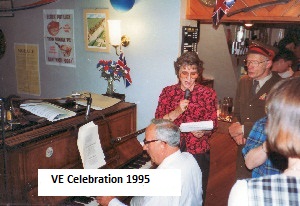
'The Bell' c. 1900. Still going strong!
'The George' 1938-Closed early 1970s


The Kings Arms can be seen in the background .C. 1870. It closed in1967
 'The Bell' c. 1900. Still going strong! |
'The George' 1938-Closed early 1970s  |
 The Kings Arms can be seen in the background .C. 1870. It closed in1967 |
| WINSHAM AT WORK-THE INNS OF WINSHAM This subject is covered very well in the book ‘The Winsham I Remember’ by W.D. Paull. Now out of print, it is reproduced by permission of his granddaughter Suzanne Butler on this web site. However, for the most part, this wonderful record only tells of Winsham during the first two decades of the last century. There are also many references to all the inns throughout the Web Museum, especially in the Winsham Memories area. This museum area is aimed towards bringing these references together, and also adding information where possible. Most of this information is anecdotal, but from reliable sources, often with family links to the businesses. We welcome further contributions. The links below take you to further sources of information about Winsham's hostelries. Click HERE for link to 'The Winsham I Remember' (W.H.Paull), or go to Wartime and after (Dennis Summers) and My Memories if Winsham 1944-1962 (Robert Warren). Other references abound throughout the Web Museum |
| 'The Kings Arms'
The Kings Arms was most popular especially during World
War II .The reason was that the Jubilee Hall was directly
opposite. In those days there would be dances on Wednesday and Saturday
nights and the locally stationed American troops and our local boys who
were on leave would take advantage and enjoy this function. Cider was
the popular drink, having disastrous consequences at times ( all types of
beer of course were on ration and in short supply).
Before the
World War II he also ran, twice a week, a produce market in the covered
yard, but this was a market a little different. He would buy from the
Winsham locals all sorts of items in season such as pheasants, rabbits,
wild mushrooms, wild blackberries, plovers eggs, etc.
Tommy would bundle all his wares together -take them to Chard Junction
and put them on the Waterloo train to arrive in the London markets by
morning !! |
| 'The Bell' The Bell was tenanted by a well known Winsham family. William Partridge held the tenancy for just under thirty years, from 1924 until 1953. Prior to that Mr Hart had run the tenancy. Ernie Partridge, his son, tells of a happy and lively childhood, with his brothers and sisters. William, in addition to the pub business, used to keep eight cows, which lived in several  fields around the village, which he would rent for the purpose. The milk would be sold around the village. During an outbreak of Foot & Mouth Disease, he was unable to move his cows for milking. Fortunately they were grazing in the field adjacent to the cemetery, so he was able to tie them up to the Cemetery fence and milk them there! The village milk supply was maintained! Before the war he also carried on a lively trade in collecting eggs, chickens (alive and dead) from the many small farms in the area, and sending them to market in London. He also erected a corrugated iron shed in what is now the garden of ‘The Bell’, and on a Saturday night used to sell fried fish & chips. It was popular with villagers and they used to do a very good trade. This continued during the war, but very often rabbit was used as a substitute for fish, which was sometimes hard to get, especially during the early years of the war. |
| The George Inn The George Inn, in Back Street, and fronted by the Market Cross and the water pump, was in its later years a tenanted pub, owned by Brutton, Mitchells & Toms. In 1937, the Chard Brewery was closed, having served the thirst of local inhabitants since 1825. Before The George closed in the early 1970s, it had a number of tenants, the names of most still well known in the village to-day (2013), their families have remained in the community. Tenants after the Great War included Frank & Ivy Peadon, Reg & Sarah Grabham, whose daughter Linda married Ken Slade, the builder who lived in Fore Street. Then followed Mr & Mrs Spencer Barnes, who in turn were followed by the Cameron family, who had recently returned from Sri Lanka. It is thought that they were the last licensees. |
| The Knapp Inn The Knapp Inn ceased to trade in the early 20th Century, when the proprietor Mr Birfield, became tenant of the newly built Victoria Inn at Victoria Street, Chard. The Knapp Inn was on the site of Heron House at Bridge. Before that the proprietor was Mr William Bonfield. The Inn was well spoken of in the 'Book of the Axe', written 1875 (2nd Edition) by the Victorian gentleman and keen fisherman, G.R. Pulman where the author spoke eloquently about the quality of the food available to the casual way farer. Mr Birfield was without doubt a man possessed of admirably acute 20/20 vision when it came to pinpointing the gleam of gold at Leigh. He had unearthed 300 Charles I gold pieces from beneath the roots of a laburnum tree in the gardens at Leigh.
|
Click HERE to return to Winsham at Work index
March 2013